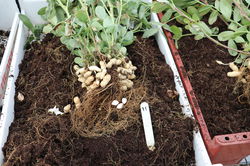 Peanuts are a commodity: one eats them thoughtlessly in front of the television or while sitting on a barstool, hardly ever thinking about the plant or how to grow it. They are the epitome of industrial food. But peanuts, in particular the Lubera varieties, which can now be grown in northern regions, have a lot to offer: tasty nuts, which are actually beans, different seed coat colours ranging from white, pink and red to striped and black. In addition, there is also diversity in the growth types, pods and fruit sizes. But the most exciting story this plant has to tell is certainly its fruit development trick, where it literally buries its head, its fertilised flowers, in the sand...
Peanuts are a commodity: one eats them thoughtlessly in front of the television or while sitting on a barstool, hardly ever thinking about the plant or how to grow it. They are the epitome of industrial food. But peanuts, in particular the Lubera varieties, which can now be grown in northern regions, have a lot to offer: tasty nuts, which are actually beans, different seed coat colours ranging from white, pink and red to striped and black. In addition, there is also diversity in the growth types, pods and fruit sizes. But the most exciting story this plant has to tell is certainly its fruit development trick, where it literally buries its head, its fertilised flowers, in the sand...
As ubiquitous as the peanut is in our part of the world, it is practically unknown because it has hardly been cultivated here until now. In the following, we try to answer the most important questions regarding peanuts...
1. Can peanuts be grown in our region?
A few years ago this question would certainly have been answered in the negative, but the climate has changed considerably since then. Various statistics show a temperature increase of 1 to 1.5°C north of the Alps and so growing peanuts has suddenly become possible. However, it is important to select ideally suited varieties that can tolerate a certain amount of moisture in both the summer and autumn, i.e. during the development and ripening period of the peanuts and pods.
Today, the peanut is professionally cultivated in the tropics and subtropics; however, one should never forget that it originally comes from the Andes and is adapted to different climates there. We at Lubera have taken advantage of this fact and have tested and selected South American local breeds from which we expect to have a better adaptability to our climate.
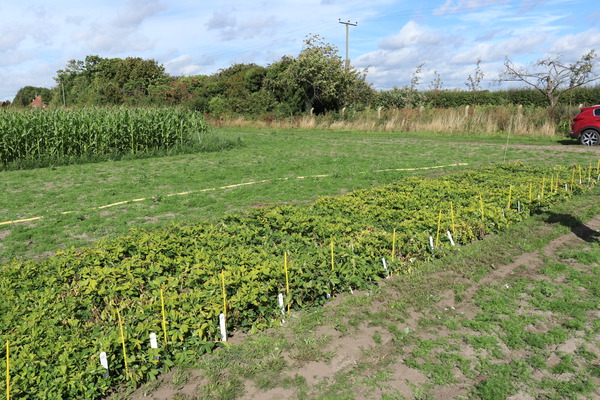
Picture: Selekcion field for Peanuts in the UK
2. Is the peanut an annual plant or does it continue to grow like a nut tree?
Well, the peanut should not be compared with a nut tree, despite its name...In our region, the peanut is an annual plant; in autumn the leaves turn brown, the shoots dry up and the peanuts themselves would probably rot in the ground if they weren’t harvested. In subtropical and tropical regions of the world, the peanut potentially grows all year round. The peanuts in the soil germinate again, giving the plant a long – or almost eternal – life. When selecting varieties, special attention must therefore also be paid in the subtropics to varieties that do not start to germinate again, but have natural germination inhibition and can therefore be harvested in a calm state.
3. Are peanuts really nuts?
The peanut, botanically called Arachis hypogaea, is not really a nut, but a legume crop within the Fabaceae family. It therefore belongs to the same subfamily as peas and beans. To put it even more clearly, peanuts are actually beans; the pod of peanuts is comparable to a bean pod. The name peanut clearly indicates the relationship to beans and other legumes. The term “nut” is a descriptive-comparative term, derived from the firm and crunchy shell (which may resemble a nutshell...). The taste of the peanut may also have played a role in the nut association, which in addition to the green tones of beans also has nutty and sweetish accents, especially when fully ripe and dried.
4. To which plant could the peanut best be compared?
As already mentioned above, the peanut can best be compared with a bean with which it belongs to the same subfamily. Peanuts like beans can also fix nitrogen via nodule bacteria. The shape of the pods in the Fabaceae family is also very similar.
5. How is it that the peanuts grow in the soil?
Peanut plants produce flowers that fertilise themselves; they are somewhat hidden under the leaves and very close to the shoots. After fertilisation, 2 to 20 cm long stems (so-called pegs) develop at the base of the carpel, behind the fertilised flower, so to speak. At the tip, the stem bears the still tiny fruit, which it penetrates into the soil as quickly as possible, where the pod and the seeds, the peanuts, are then produced. The process itself probably best describes it as a protective measure: the peanut plant literally buries its head, its direct descendants, in the sand in order to protect them from predators, perhaps even from changing climates.
6. What is new about the (Not) just Peanuts® peanuts from Lubera?
The (Not) just Peanuts® varieties from Lubera have been selected from local South American breeds. They have an upright, rather sparse and very healthy growth and they withstand moisture and rain in August and September much better than standard American varieties. So-called runner varieties, which form low-lying shoots, have been excluded from the outset, as they need even more heat and sun. Our selected peanut varieties show an impressive diversity that surprises everyone who has been nibbling peanuts at the bar or in front of the TV for years and decades: peanuts can be large and small, round and oblong, their seed coat can be black to pink, even white-red striped with a signal character; and the size of the pods varies from varieties that have almost only one nut per pod to the large peanut Justmore®, which bears an average of 3.5 nuts in one pod, which are also very large and sweet-tasting.
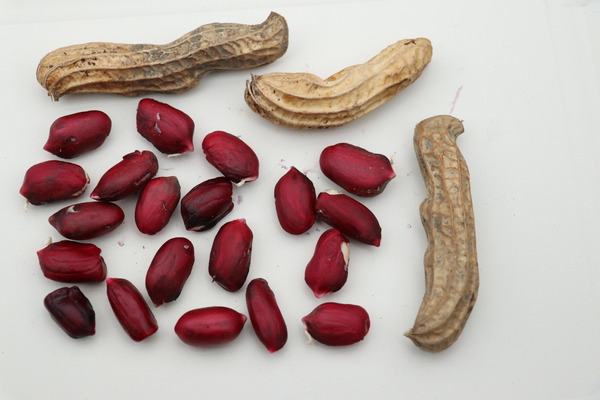
Picture: Peanut variety (Not) Just Peanuts® Justmore®
7. I have heard of the slogan (Not) just Peanuts. Where does it come from?
Yes, we will admit that it's stolen. This was one of the slogans with which Jimmy Carter, perhaps the most honest President of the United States in the last 100 years, used when he ran for president. For the late-born among our readers: Jimmy Carter was and is a peanut farmer.
8. When is the best time to plant peanuts in our region?
In our climate, you can plant peanuts from early May to early June. If spring frosts should still be feared after planting, it is worth covering and protecting the fresh planting with a fleece.
9. When are peanuts harvested?
Around the middle of September. You can also tell the ideal harvest time from the condition of the leaves. Peanuts should be harvested when about half to three-fourths of the foliage has turned grey and brown, but when the stems are still largely green. Once all of the foliage has dried out and rotted and the stems are brown, there is a risk that the peanuts, which are slumbering in the damp soil without further support, will either start to rot or germinate again due to stress in order to ensure their own survival.
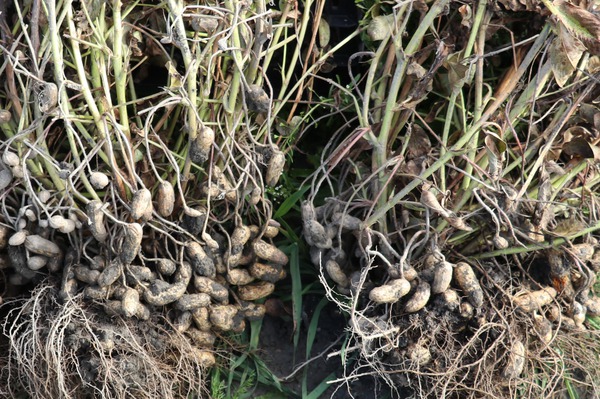
Picture: freshly harvested Peanut plants in Buchs (CH)
10. What should be observed after the harvest?
The peanuts or, above all, the peanut pods must be dried immediately after digging up the plants. To do this, place the pods in a single layer in a box and put them in a warm room that is over 20°C, ideally with ventilation. It is even easier if you can dry them in an oven with circulating air or gently in a dehydrator but still with enough warm air. This immediate drying process is important in that it prevents the dangerous and poisonous formation of mould in peanuts that are moist and too close together.
11. Do peanuts have to be roasted?
No, you can enjoy peanuts unroasted, both freshly green and dried. The fresher and “greener” the peanuts are, the more they are reminiscent of beans. The drier they are, the nuttier they taste. Unlike beans, peanuts are non-toxic when uncooked, apart from the danger of mould.
Cooked peanuts are a popular snack, especially in the growing regions in the southern states of the United States and in South-East Asia. For this purpose, the freshly harvested and cleaned but not yet dried peanuts are boiled in the pods in salted water for about 30 minutes. The nuts can then be eaten directly from the pods. The longer the peanuts are cooked, the softer the nuts become. By adding different spices to the cooking water, the taste can also be varied.
For longer safe storage and for spiced snacks, however, peanuts must be roasted. To do this, the pods must first be opened and then you can decide whether you want to remove the coloured seed coats as well. The best way to do this is to freeze the peanuts for a short time, and after defrosting, the seed coats can be easily removed. Alternatively, the nuts can also be shaken in a container after roasting; afterwards, the seed coats can be easily blown away with a hairdryer...
12. How does the roasting of peanuts work?
For roasting, the shelled or unshelled peanuts are placed in a single layer on a baking tray with baking paper. The oven is preheated to 180°C with top and bottom heat. The laid out baking tray with the nuts is placed in the oven and after about 10 minutes the nuts can be carefully stirred and moved once. Roasting takes 15-20 minutes with shelled nuts and about twice as long with unshelled nuts.
13. How can peanuts for snacking be seasoned?
If you want to season or sweeten peanuts, this should always be done after roasting, with the still-warm nuts, which can best bind and absorb the sweeteners and seasonings. (Almost) everything that is tasty and pleasing is allowed: besides salt and pepper, various other spices can be used. Even sweet flavours using sugar, cinnamon and honey are possible and go perfectly with the nutty natural taste of peanuts.
14. Can peanuts also be grown outside in the garden?
Our Lubera peanut varieties can easily be grown outdoors from central England to Switzerland, ideally in light, sandy soil. If the soil is heavier, it is advantageous to mix a lot of well-stored compost into the planting bed and use it to build up an approx. 30-40 cm wide mound on which the peanuts are planted. We recommend a distance of 40 cm between the rows and 30 cm in the row. With this distance, the soil is well covered and only a few weeds can come up.
15. What should be considered when growing peanuts in a container or pot?
Ultimately, the fertilised flowers must be able to grow towards the ground with their stems and penetrate into the soil. Peanuts should therefore be grown in a pot with a volume of at least a 5 L (larger pots are also possible). A balcony box is also possible and the planting distance should be about 30 cm. Pots and balcony boxes should not have saucers, as standing water is not appreciated by this drought-loving plant and especially by its fruits formed in the soil. In the case of deeper pots, a drainage layer should be provided at the bottom in order to ensure good drainage.
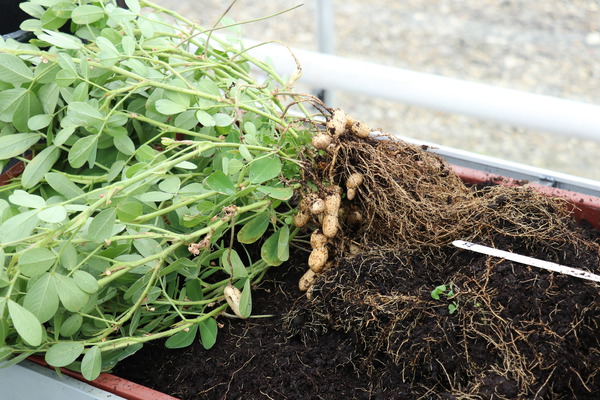
Picture: You also could harvest Peanuts in big pots
16. How many peanuts can be harvested?
The harvest can be surprisingly large. A high-yielding variety such as Justpink® can bear up to 100 pods in light soil or on a mound, which then contains well over 200 peanuts. More special, large-fruited and very rich in content varieties such as the signal variety Justbehappy® may bring about 50 pods to maturity, but this still equals 100 nuts, all with the spectacular red-and-white stripes to compensate.
17. Which varieties are best suited to colder and wetter locations?
In our tests, the varieties Justmore® and Justblack® proved to be the most resistant to cooler temperatures and wetter weather. They keep their leaves much longer than the other varieties and also the stems stay green up to four weeks longer, so the pods and nuts can take a little longer to ripen.
18. Can the harvested nuts be sown again?
Similar to tomatoes, peanuts are largely self-fertile, i.e. they are fertilised by the male organs of their own flowers. The peanuts that have been carefully and gently dried and stored in a dry place can be sown again in the spring. But if you can't resist the temptation to nibble and nibble, you can always rely on Lubera young plants.
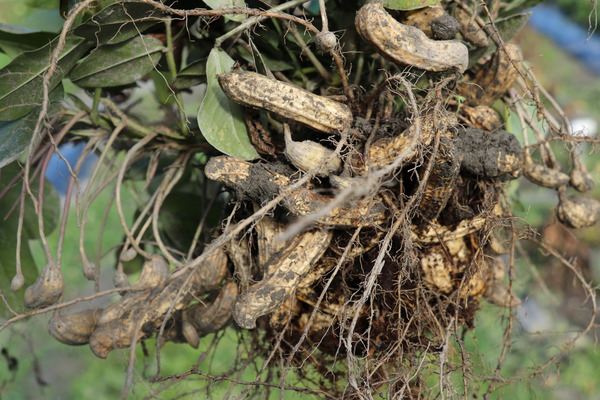
Picture: fully-ripen Peanut shells under a fresh harvested Peanut plant
